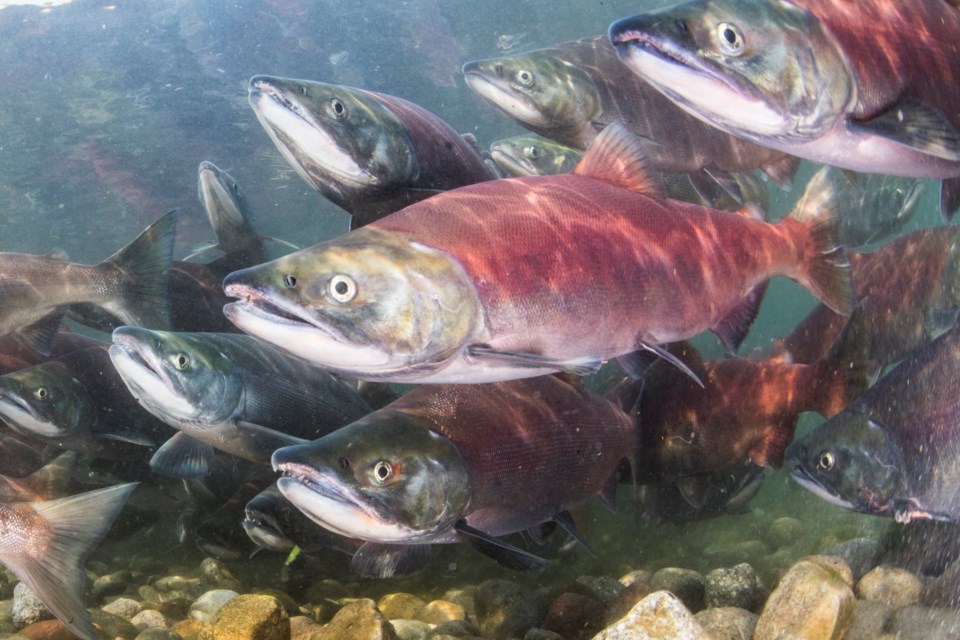Of the 785,779 Fraser River sockeye harvested to date, American commercial fishermen harvested 310,480, of which American treaty tribes accounted for 236,126, according to the Pacific Salmon Commission (PSC).
Canadian First Nations caught 419,406 Fraser River sockeye for food, social and ceremonial (FSC) purposes.
Canadian commercial fishermen have caught zero Fraser River sockeye. And it is beginning to look like that number may not go up.
Despite some promising returns of sockeye salmon to the Skeena River and Barkley Sound this year, Canadian commercial fishermen now face the prospect of being shut out of the once-lucrative Fraser River sockeye harvest for a fourth year in a row.
They had hoped for a commercial opening to be announced Friday. Based on projections from the PSC, the American caucus of the Fraser River Panel sanctioned a commercial opening, while the Canadian caucus decided to wait to see if late summer returns improved.
Commercial fishermen were told an opening might be announced Tuesday, which came and went with no green light.
Now, they need to wait until Friday for a meeting of the Fraser River Panel to learn if there will be any openings this year for Fraser River sockeye. If there is, it will likely be very limited.
“It isn't looking promising but there is still a fair bit of uncertainty in the late run return,” Matt Mortimer, a resource manager for Fisheries and Oceans Canada, Pacific region, said in an email.
This is supposed to be a dominant year for Fraser River sockeye, which historically have returned in greater abundance every four years. The pre-season forecast was for 9.8 million Fraser River sockeye returns this year.
But the current run sized adopted by the PSC is now just 5.5 million – better than the previous three years, and sufficient to satisfy First Nation FSC requirements, but poor for a dominant year.
The summer run of Fraser River sockeye have returned in relative abundance, with an adopted run size of 3.5 million fish (about 900,000 shy of the pre-season forecast). But so far, the run size for Adams River sockeye (late summers) is estimated at just 1.2 million – a third of the pre-season forecast of 3.7 million.
Canadian fisheries managers are being more cautious than their American counterparts when it comes to commercial openings because of concerns over the late summer run.
That caution may have cost south coast salmon fishermen their only chance to catch sockeye this year.
“Because they waited too long to let us fish on the summer run, now we can’t go fishing because we’d be impacting the lates (late summer),” said Dawn Webb, an organizer for the UFAWU-Unifor fisherman’s union.
Results of a high-seas scientific expedition in the Gulf of Alaska over the winter had actually warned that Adams River sockeye returns might be poor this year – underscoring how valuable these expeditions could become for fisheries managers as another tool in their forecasting belt.
A fourth consecutive year of no commercial opportunities for Fraser River sockeye will be devastating to the south coast salmon fleet, Webb said.
“The south coast salmon fleet is done,” she said.
In recent years, because of declining Fraser River sockeye, 80% of the income for the south coast salmon fleet came from chum salmon, Webb said, and then that got cut. Closures on chum were implemented to protect steelhead.
“They implemented rolling window closures that they put in place in 2019 that impacted our ability to harvest chum drastically because it pushed us so that we’re not actually fishing when the chum are there,” Webb said.
Under the Pacific Salmon Treaty, American commercial and tribal fishermen are allowed a share of Fraser River sockeye, and the two countries cooperate on its management.
This year, based on the forecasts of the PSC, American fisheries managers felt the returns were strong enough to support a commercial fishery, while Canadians decided to wait to see if the late summer run sizes improve.
Of the 785,779 Fraser River sockeye that have been harvested to date, here’s how it breaks on either side of the U.S.-Canada border, according to the PSC:
American commercial: 310,480
Canadian commercial: 0
American Treaty Tribes: 236,126
American treaty ceremonial and subsistence: 11,514
American non-treaty commercial: 74,354
Canadian First Nation FSC: 419,406
Canadian First Nation commercial: 0



